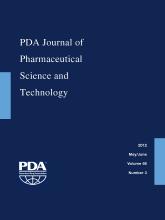Abstract
The major compendia require sterile injectable and ophthalmic drugs, to be prepared in a manner that is designed to exclude particulate matter. This requirement is satisfied by testing for subvisual particles in the laboratory and 100% inspection of all containers for the presence of visible particles. Inspection for visible particles is performed in the operations area using one of three methods. Manual inspection is based on human visual acuity, the ability of the inspector to discern between conforming and nonconforming containers, and the ability to remove nonconforming units. Semi-automated inspection is a variation of manual inspection, in which a roller conveyor handles and presents the containers to the human inspector. Fully automated inspection systems perform handling, inspection, and rejection of defective containers. All inspection methods must meet the compendial requirement for sterile drug product to be “essentially free” of visible particulates.
Given the random occurrence of particles within the batch, visual detection of a particle in an individual container is probabilistic. The probability of detection for a specific particle is affected by many variables that include product attributes, container size and shape, particle composition and size, and inspection capability. The challenge set is a useful tool to assess the particle detection in a product, and it may also be used to evaluate detection of container/closure defects. While the importance of a well-designed challenge set is not always recognized or understood, it serves as the cornerstone for qualification and/or validation of all inspection methods. This article is intended to provide useful information for the design, composition, and use of container challenge sets for particulate inspection studies.
LAY ABSTRACT: Regulations require drug products intended for injection or ophthalmic use to be sterile and free of particles that could harm the patient. This requirement is meet by 100% inspection of every drug container in the lot and the removal of any defective unit before it is released for patient use. Great progress has been made through the creation of a harmonized method for the detection of small particles in drug product and universal recognition of container defects.
Differing opinions concerning the conduct of large particle inspection have hindered the creation of a harmonized method. The absence of a standard method has created confusion that must be resolved for acceptance of drug products in the global marketplace. While the importance of a well-designed test set for qualification of these methods is overlooked or misunderstood, it can serve as the cornerstone for qualification of all inspection methods. This article is intended to provide valuable information for test sets used qualify inspection systems. The proper design and use of these test sets will provide clarity for inspection qualification, which can be applied to the inspection of commercial product.
- Challenge sets
- Container/closure defects
- Inspection validation
- Kits
- NIST spheres
- Particle inspection
- Particulate matter
- © PDA, Inc. 2012
PDA members receive access to all articles published in the current year and previous volume year. Institutional subscribers received access to all content. Log in below to receive access to this article if you are either of these.
If you are neither or you are a PDA member trying to access an article outside of your membership license, then you must purchase access to this article (below). If you do not have a username or password for JPST, you will be required to create an account prior to purchasing.
Full issue PDFs are for PDA members only.
Note to pda.org users
The PDA and PDA bookstore websites (www.pda.org and www.pda.org/bookstore) are separate websites from the PDA JPST website. When you first join PDA, your initial UserID and Password are sent to HighWirePress to create your PDA JPST account. Subsequent UserrID and Password changes required at the PDA websites will not pass on to PDA JPST and vice versa. If you forget your PDA JPST UserID and/or Password, you can request help to retrieve UserID and reset Password below.






